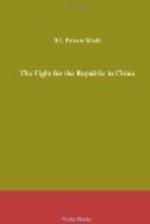To say this is to give utterance to nothing very new or brilliant: it is the thought which has been present in everyone’s mind for a number of years. So far back as 1902, when Great Britain negotiated with China the inoperative Mackay Commercial Treaty, provision was not only made for a complete reform of the Tariff—import duties to be made two and a half times as large in return for a complete abolition of likin or inter-provincial trade-taxation—but for the abolition of extraterritoriality when China should have erected a modern and efficient judicial system. And although matters equally important, such as the funding of all Chinese indemnities and loans into one Consolidated Debt, as well as the withdrawal of the right of foreign banks to make banknote issues in China, were not touched upon, the same principles would undoubtedly have been applied in these instances, as being conducive to the re-establishment of Chinese autonomy, had Chinese negotiators been clever enough to urge them as being of equal importance to the older issues. For it is primarily debt, and the manipulation of debt, which is the great enemy.
Three groups of indebtedness and three groups of restrictions, corresponding with the three vital periods in Chinese history, lie to-day like three great weights on the body of the Chinese giant. First, there is the imbroglio of the Japanese war of 1894-5; second, the settlement following the Boxer explosion of 1900; and third, the cost of the revolution of 1911-1912. We have already discussed so exhaustively the Boxer Settlement and the finance of the Revolutionary period that it is necessary to deal with the first period only.
In that first period China, having been rudely handled by Japan, recovered herself only by indulging in the sort of diplomacy which had become traditional under the Manchus. Thankful for any help in her distress, she invited and welcomed the intervention of Russia, which gave her back the Liaotung Peninsula and preserved for her the shadow of her power when the substance had already been so sensationally lost. Men are apt to forget to-day that the financial accommodation which allowed China to liquidate the Japanese war-debt was a remarkable transaction in which Russia formed the controlling element. In 1895 the Tsar’s Government had intervened for precisely the same motives that animate every State at critical times in history, that is, for reasons of self-interest. The rapid victory which Japan had won had revived in an acute form the whole question of the future of the vast block of territory which lies south of the Amur regions and is bathed by the Yellow Sea. Russian statesmen suddenly became conscious that the policy of which Muravieff-Amurski in the middle of the nineteenth century had been the most brilliant exponent—the policy of reaching “warm water”—was in danger of being crucified, and the work of many years thrown away. Action on Russia’s part was imperative; she was great enough to see that;




